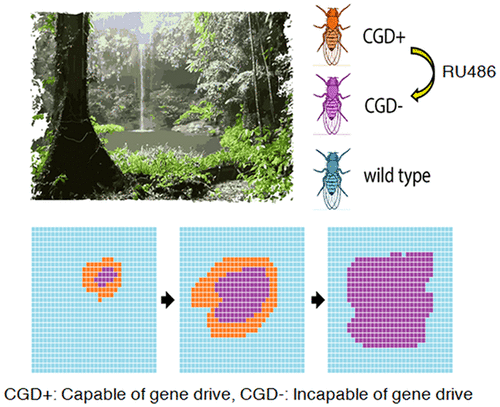当前位置:
X-MOL 学术
›
ACS Synth. Biol.
›
论文详情
Our official English website, www.x-mol.net, welcomes your feedback! (Note: you will need to create a separate account there.)
Chemical Controllable Gene Drive in Drosophila.
ACS Synthetic Biology ( IF 4.7 ) Pub Date : 2020-07-31 , DOI: 10.1021/acssynbio.0c00117 Dongwoo Chae 1 , Junwon Lee 2 , Nayoung Lee 3 , Kyungsoo Park 1 , Seok Jun Moon 3 , Hyongbum H Kim 1, 4, 5, 6
ACS Synthetic Biology ( IF 4.7 ) Pub Date : 2020-07-31 , DOI: 10.1021/acssynbio.0c00117 Dongwoo Chae 1 , Junwon Lee 2 , Nayoung Lee 3 , Kyungsoo Park 1 , Seok Jun Moon 3 , Hyongbum H Kim 1, 4, 5, 6
Affiliation

|
Gene drive systems that propagate transgenes via super-Mendelian inheritance can potentially control insect-borne diseases and agricultural pests. However, concerns have been raised regarding unforeseen ecological consequences, and methods that prevent undesirable gene drive effects have been proposed. Here, we report a chemical-induced control of gene drive. We prepared a CRISPR-based gene drive system that can be removed by a site-specific recombinase, Rippase, the expression of which is induced by the chemical RU486 in fruit flies. Exposure of fruit flies to RU486 resulted in 7–12% removal of gene drive elements at each generation, leading to a significant reduction in gene drive-fly propagation. Mathematical modeling and simulation suggest that our system offers several advantages over a previously reported gene drive control system. Our chemical control system can provide a proof-of-principle for the reversible control of gene drive effects depending on ecological status and human needs.
中文翻译:

果蝇中的化学可控基因驱动。
通过超孟德尔遗传传播转基因的基因驱动系统可以潜在地控制虫媒疾病和农业害虫。然而,人们对不可预见的生态后果提出了担忧,并且已经提出了防止不良基因驱动效应的方法。在这里,我们报告了基因驱动的化学诱导控制。我们准备了一个基于 CRISPR 的基因驱动系统,它可以被位点特异性重组酶 Rippase 去除,Rippase 的表达由果蝇中的化学物质 RU486 诱导。果蝇暴露于 RU486 导致每代基因驱动元件去除 7-12%,导致基因驱动-果蝇繁殖显着减少。数学建模和模拟表明,我们的系统比之前报道的基因驱动控制系统具有多个优势。
更新日期:2020-09-20
中文翻译:

果蝇中的化学可控基因驱动。
通过超孟德尔遗传传播转基因的基因驱动系统可以潜在地控制虫媒疾病和农业害虫。然而,人们对不可预见的生态后果提出了担忧,并且已经提出了防止不良基因驱动效应的方法。在这里,我们报告了基因驱动的化学诱导控制。我们准备了一个基于 CRISPR 的基因驱动系统,它可以被位点特异性重组酶 Rippase 去除,Rippase 的表达由果蝇中的化学物质 RU486 诱导。果蝇暴露于 RU486 导致每代基因驱动元件去除 7-12%,导致基因驱动-果蝇繁殖显着减少。数学建模和模拟表明,我们的系统比之前报道的基因驱动控制系统具有多个优势。



























 京公网安备 11010802027423号
京公网安备 11010802027423号